
* Two aircraft are associated in the mind of every aviation enthusiast with the Battle of Britain in the summer of 1940: the Supermarine Spitfire and the Hawker Hurricane. Of course, both these machines had significant careers in other theaters and battles through the war, and though the Spitfire tends to be the star aircraft, the Hurricane was at least as important, particularly in holding the line during the difficult early years of the war. This document provides a history and description of the Hurricane.
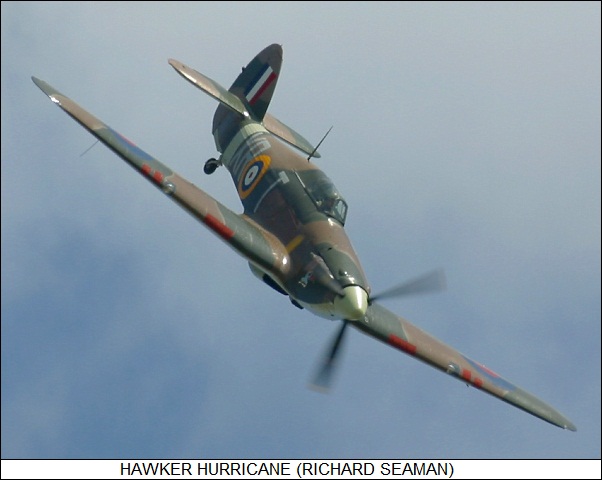
* During World War I, the Sopwith Aviation Company had contributed a number of significant fighters to the Allied war effort, including the "Tabloid", "1-1/2 Strutter", "Pup", "Triplane", and "Dolphin". In the postwar period, when Sopwith Aviation became Hawker Engineering, the renamed company produced another series of biplane fighters, culminating in the early 1930s with the Hawker "Fury".
The introduction of the Fury gave the British Royal Air Force (RAF) one of the most advanced combat aircraft of its day. Sydney Camm of Hawker, chief designer since 1925 and responsible for the Fury, felt like taking the design one step further. In 1933, he came up with a proposal for a "Fury Monoplane", with fixed landing gear in spats, four machine guns, and powered by a 492 kW (660 HP) steam-cooled Rolls-Royce Goshawk engine. Camm spoke with British Air Ministry officials about the concept to get feedback. Their response led him to consider improvements, with his thinking strongly influenced by the arrival of new aircraft technologies.
Rolls-Royce had developed an advanced water-cooled, 12-cylinder inline vee engine, the "PV.12" -- where "PV" stood for "Private Venture" -- later to be known as the "Merlin", that offered much better performance than existing engines. In addition, the Birmingham Small Arms (BSA) company had obtained a license for the US Browning / Colt 7.62-millimeter (0.30-caliber) machine gun, and was rechambering it for the British 7.7-millimeter (0.303-caliber) round.
British fighters had traditionally used the heavier and older Vickers machine gun, which was prone to jams, and so fighters armed with them were usually restricted to two guns, mounted in the nose ahead of the cockpit, where the pilot could get at them to clear the jams. The Browning was more reliable and lighter, permitting it to be mounted in the wings in numbers, increasing a fighter's firepower. A high-performance fighter needed more firepower since a fast aircraft would have less "time on target" when trying to shoot down an adversary and less opportunity to score hits.
In May 1934, prompted by the improved fighter designs coming out of Hawker, the Air Ministry issued a draft specification designated "F.5/34", specifying a monoplane fighter with a speed of over 480 KPH (300 MPH) and suggesting heavy armament of six or eight guns. Hawker submitted a formal design to the Air Ministry on 4 September 1934 that featured the PV.12 engine, though the aircraft was still to be armed with four Vickers guns. Camm was planning on incorporating the Brownings, but he lacked the technical data to do so for the moment.
The Air Ministry wrote a full specification, "F.36/34", in response to the plans. A mockup was built in December, and a contract for a single prototype was awarded to Hawker on 21 February 1935. The contract was amended in July 1935 to specify fit of eight Browning 7.7-millimeter machine guns in the wings.
The silver F.36/34 prototype performed its first flight on 6 November 1935, with Hawker's chief test pilot, Flight Lieutenant P.W.S. "George" Bulman at the controls. The aircraft was powered by a Merlin C engine, with 764 kW (1,025 HP) for take-off. On landing, Bulman told Camm: "Another winner, I think!" The flight was about four months after the first flight of its future adversary, the Messerschmitt Bf 109, and about four months before the first flight of its "rival", the Supermarine Spitfire.
On 7 February 1936, Bulman handed the prototype over to the Air Ministry's Aeroplane & Armament Experimental Establishment (A&AEE) at Martelsham Heath in Suffolk for formal evaluation. Most of the testing was performed by Sergeant (later Group Captain) "Sammy" Wroath. Initial flights were unarmed, with the eight Browning machine guns finally installed in August 1936.
The fighter demonstrated a top speed of 507 KPH (315 MPH), well above specification, and its handling was excellent, at least relative to its high performance. The Merlin engine proved balky and troublesome, but that was to be expected since it was still in development. Fortunately, none of the engine troubles proved a danger to the aircraft; its loss would have been a major setback to the program, since there was no second prototype aircraft in the works.
The Air Ministry dithered on committing to the new fighter, but feedback from the A&AEE evaluation was so positive that in March, on the expectation of production orders, the chairman of Hawker, T.O.M. (later Sir Thomas) Sopwith proposed tooling up for the production of a thousand of the new fighters in January 1936 at their plant in Kingston and a new plant at Langley. The board of directors agreed to his proposal.
In April, the A&AEE issued a report to the Air Ministry on the evaluation of the F.36/34 prototype, praising it and identifying only a few minor teething problems. The Air Ministry came through with an order for 600 production machines on 3 June 1936. This was the largest single order for a combat aircraft placed by the Air Ministry in peacetime up to that date. The Air Ministry publicly announced on 27 June 1936 that the new fighter would be named the "Hurricane".
Development was delayed as Rolls-Royce continued to refine the Merlin, working through several unreliable prototype variants up to the first satisfactory type, the "Merlin G" or "Merlin II", with 768 kW (1,030 HP). Not only did the engine changes mean that Hawker couldn't get their hands on Merlins in quantity as soon as desired, but Camm's team also had to redesign the fighter's cowling to accommodate the Merlin II's modified form-factor. The tweaks to the aircraft were reflected in an updated specification designated "F.15/36".
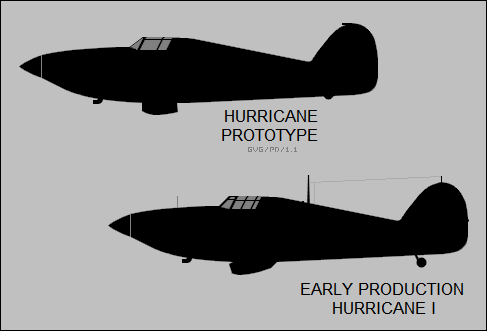
* Despite all the difficulties, the first production aircraft, designated "Hurricane Mark I", performed its initial flight on 12 October 1937, with Flight Lieutenant Philip G. Lucas at the controls. Along with the uprated engine, other changes to the production machine relative to the initial prototype configuration included:
Initial service deliveries were to RAF Number 111 Squadron at Northolt near London on 17 December 1937, with Numbers 3 and 56 Squadrons receiving their Hurricanes during 1938. It was the first monoplane fighter to go into formal RAF service, as well as the RAF's first operational fighter with a retractable undercarriage, an enclosed cockpit, and a speed greater than 480 KPH (300 MPH) in level flight.
* By the end of 1938, about 200 Hurricanes were in service, and the RAF had upped the original order of 600 to 1,000 in November, following the Munich Crisis in late September. There were some problems with losses due to accidents. Although the Hurricane's handling was good, it was still much faster than the biplane fighters RAF pilots were familiar with, and some pilots had trouble making the transition. One pilot from 111 Squadron commented that after the "ladylike Gauntlet, the Hurricane was, by comparison, a large, powerful, high-performance modern fighter."
Those who did make the transition found the Hurricane impressive. On 10 February 1938, Number 111 Squadron Leader John W. Gillan flew his Hurricane from Turnhouse, Scotland, to Northolt, covering 526 kilometers (327 miles) in 48 minutes. This gave an average speed of 658 KPH (409 MPH), and introduced the Hurricane to the British public with a splash of publicity. Such a high speed was a good margin above the Hurricane's normal limits of performance, but there had been a strong tailwind, not mentioned in the newspaper articles. Gillan would be known as "Downwind" Gillan from then on.
The RAF was facing war and needed as many Hurricanes as they could get their hands on, with the total order raised again, this time to 1,500 machines. The Gloster company was enlisted to also build the fighter, tooling up their factory at Hucclecote, Gloucestershire to build Hurricanes. Gloster turned out their first example on 27 October 1939.
* The initial prototype Hurricane had been phased out of testing in early 1937, but got to star in a movie, TEST PILOT with Clark Gable, the aircraft actually being flown by Sammy Wroath. It then went into storage and eventually disappeared without any trace, though there are tales that it may have been pressed into service for a little wartime air-defense duty, and even shot down a German bomber.
BACK_TO_TOP* The Hurricane Mark I was a low-wing monoplane with tailwheel landing gear. The main gear hinged in the wings to retract towards the fuselage, giving the machine a comfortable wide track on the ground. This was an important feature, since in those days RAF airstrips were grass-covered. The aircraft had a "razorback" cockpit configuration, with the canopy sliding straight back.
The Hurricane Mark I was of old-fashioned construction, built around a steel-tube box structure fleshed out with wooden frames and stringers. Although the cowling and the cockpit had metal sheathing, the rest of the aircraft was covered by fabric. Late Hurricane I production featured a metal wing, originally evaluated in 1939, which was also retrofitted to many older Hurricanes. The metal wing still retained cloth-covered control surfaces.
The relatively unsophisticated construction of the Hurricane meant it was heavier than it really needed to be, but it was also a plus in some ways, in that it made for easy manufacture and maintenance, and it was also very rugged. Other improvements during Hurricane I production included addition of an armor-glass windscreen and some cockpit armor.
Four Browning 7.7-millimeter machine guns were mounted in a single bay in each wing, firing outside the propeller arc. Elimination of the synchronizing gear needed for firing through a propeller arc both reduced weight and improved reliability. The guns were easily accessed for service and loading. The innermost gun in each wing had an ammunition box with a capacity of 338 rounds, while the next gun had 324 rounds, and the two outer guns 338 rounds each. Cyclic rate of fire of each gun was initially 1,100 rounds per minute, though this was later improved to 1,200 rounds per minute.
The propeller fit evolved through Hurricane I production. The prototype and initial production featured a Watts fixed-pitch two-blade propeller. The RAF realized this was stodgy, but the Hurricane was needed immediately and there was nothing better available for the moment. Better propellers became available in 1939 -- first in the form of an all-metal, three-bladed, variable-pitch, constant-speed propeller, designed by Hamilton Standard of the US and license-built in Britain by de Havilland; and then the definitive Rotol (Rolls-Royce / Bristol) propeller, which was a three-bladed item similar in general description to the Hamilton Standard design, but made of wood.
The variable-pitch propellers improved performance and combat maneuverability, though they didn't become universal until well into 1940. Hurricanes were refitted with the "Merlin III" engine, which was a Merlin II that had been redesigned to fit either of the variable pitch propellers and provide a hydraulic feed to drive the pitch-changing mechanism.
Hawker built a total of 1,924 Hurricane Is, while Gloster built 1,850. Small numbers of Hawker-built Hurricane Is were also provided to export customers, as described below. Some sources describe late-production Mark Is as "Mark IAs", but this appears to be an error or an informal usage.
* When World War II broke out in September 1939, 497 Hurricanes had been built, and a total of 19 RAF squadrons were equipped with the type. Four squadrons were transferred to France to participate in the idle "Sitting War", with one shooting down a German Dornier Do 17P reconnaissance aircraft on 30 October 1939. It was the Hurricane's first kill. Further clashes followed, with the Hawker fighter demonstrating that it was as formidable in combat as it had promised to be. On 29 November, a Hurricane shot down a Luftwaffe Heinkel He 111H bomber near Newcastle, performing the fighter's first kill in defense of Britain.
When the "Sitzkrieg" ended in May 1940 with the Nazi invasion of the Low Countries and France, six more Hurricane squadrons joined in the battle, followed by another two squadrons. They might not have bothered, since the British were run out of France at Dunkirk, and all the RAF had to show for their trouble was the loss of about 200 Hurricanes, about a quarter of the service's fighter strength, along with many other aircraft. Hurricanes not in flying condition were burned to keep them from falling into enemy hands. At least their wooded construction made them easier to torch.
Britain's situation was desperate, but Hitler didn't have the capability to perform a major amphibious operation against defended English beaches; he also believed the British had lost heart in the struggle and were anxious for peace. He was wrong in this belief, but it would take a few months for him to realize it. The RAF used the breathing space to rebuild their squadrons, and when the Luftwaffe began to pound Britain in earnest in August, beginning the "Battle of Britain", the RAF had 32 squadrons of Hurricanes and 19 squadrons of Spitfires.
That still left the RAF outnumbered; the defense was weakened further by the transfer of Hurricane squadron Number 261 to Malta, and Numbers 73 and 274 to North Africa. The African Hurricanes featured a "Vokes Multi-Vee Sand Filter" to screen the carburetor intake, which had been qualified a few months before the outbreak of war in expectation of a possible clash in the desert with the Italians. The Vokes filter noticeably changed the Hurricane's nose profile, and also cut performance by about 8%.
Initially, RAF fighter pilots defending Britain against the Luftwaffe were hampered in air combat by rigid tactics that dictated flying tight massed formations to take advantage of grouped firepower. That proved impractical in fluid air fights, and the RAF quickly adopted the more flexible tactics of the Germans -- fighters going into combat in "finger-four" formations, and splitting up into pairs of wingmen, with one performing an attack while the other watched his back.
As Luftwaffe bomber formations swept over England, in principle the faster and more agile Spitfires would take on German escorts, while the Hurricane attacked the bombers. In practice it was hard to achieve such a neat division of labor, and Hurricanes did take on Bf 109s, often with success. The Hurricane was no match for the Bf 109 in speed, but the Hurricane was very tough, had the tighter turning radius, handled well, and was a "rock-steady" firing platform.

The fact that the Hurricane was easier to fly than a Spitfire was also important. Inexperienced pilots could make effective use of it. Expatriate pilots, such as the Poles and Czechs, were given Hurricanes since conversion was easier and more machines were available; they quickly mastered the aircraft. The Spitfire was still the more glamorous machine, and there was a certain "Spitfire snobbery", then and later. It even affected the Germans. A Hurricane pilot who spoke with a Luftwaffe prisoner whose Bf 109 he had shot down found the German completely insistent that he had been shot down by a Spitfire instead. However, no less than 1,715 Hurricanes took part in the Battle of Britain, and were credited with 80% of the 1,792 German aircraft shot down.
The Hurricane's Battle of Britain service tends to overshadow its other accomplishments at the time. The British were all but overwhelmed in the first few years of the war, trying to put out one fire while another blazed up elsewhere. The Hurricane Mark I was "thrown in the deep end" in all theaters during these desperate times, from Norway to Malta, generally fighting losing battles, trying to hang on until the tide could be reversed.
BACK_TO_TOP* Even as the Hurricane I was racking up kills in defense of Britain, Hawker was improving the type for the time when the Allies could take the initiative. Rolls-Royce had been working on improvements to the Merlin, developing a new version, the "Merlin XX", that had a two-speed supercharger instead of the single-speed supercharger of earlier variants, providing better optimization of engine power at different altitudes. (Some sources claim the Merlin XX had a two-stage supercharger, but that was the later Merlin 61 series.)
The Merlin XX provided 954 kW (1,280 HP). A Hurricane I was refitted with it to become the prototype for the "Hurricane Mark II" series. The prototype performed its first flight on 11 June 1940. The initial Mark II, the "Mark IIA Series 1", was essentially just a Mark I with the new engine. The first of this type went into squadron service in September 1940, just as the Battle of Britain was reaching its peak. Hawker then introduced the "Mark IIA Series 2", which featured a new wing scheme.
Two different types of wing could be fitted. One version accommodated a total of 12 7.7-millimeter Brownings, with the additional guns added to a new bay in each wing, while the other version carried four Hispano Mark II 20-millimeter cannon -- the 7.7-millimeter Brownings had clearly demonstrated a lack of hitting power in combat, and their range was inadequate. The Hurricane Mark II series was slightly longer than the Mark I, though only because a new, more streamlined prop spinner was fitted.
The first Hurricane Mark IIA Series 2 went into service in October. With further improvements to the new wing scheme, this type quickly evolved into two new variants, the variant designation depending on the wing fit. The "Mark IIB" featured the wing with twelve Brownings, and the "Mark IIC" featured the wing with the four Hispano cannon. The Mark IIB went into service in April 1941, with the Mark IIC following in June.
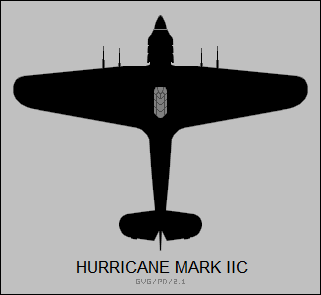
Heavy cannon had been originally been evaluated beginning in 1939 on a Mark I that had been modified to carry twin Oerlikon 20-millimeter cannon, one under each wing. The aircraft had metal wings, wooden wings having been judged too fragile to stand the recoil of large cannon. Apparently this aircraft did some fighting in the Battle of Britain and scored a kill on a Do 17. However, the Oerlikon cannon was too heavy, required greased cartridges, and wasn't designed for carriage by a fighter anyway; the Hispano cannon was a better solution. The four-cannon fit was evaluated on a Hurricane Mark I in 1940, but the machine was judged underpowered, and the four-cannon configuration had to wait for the Mark II with its Merlin XX engine.
While the Hispano cannon was notoriously unreliable as a fighter weapon in the early days of its use, often suffering from jams, the cannon itself appears to have been reliable: the problem was figuring out how to install it in a wing so the feed mechanism worked properly. The Hispano Mark II had been designed as a "motor-cannon", to be mounted between the cylinder banks of an inline engine and fire out the prop spinner, and it hadn't been designed or qualified for wing mounting. Another consequence of its design as a motor-cannon was its long barrel, which protruded well in front of the Hurricane's wings. A short-barreled Hispano Mark V would be developed later, but that was after the Hurricane's time.
In any case, the Mark I evaluated with four cannon in 1940 had belt-fed cannon that proved unreliable, and so the Mark IIC went into production with drum-fed cannon. It is unclear if there were any unusual level of teething problems with the cannon on the Mark IIC. Apparently the outer cannon in each wing was sometimes removed to reduce weight at the expense of firepower. Some sources claim that Oerlikon cannon were sometimes fitted instead of Hispano cannon, but that seems a bit implausible.
Even with the Merlin XX engine, the Hurricane's performance was falling well behind that of the latest models of German fighters, and so in 1941 it was being refocused on the fighter-bomber role, becoming known as the "Hurribomber". Both the Mark IIB and Mark IIC featured a stores pylon on each wing that could carry a single 113-kilogram (250-pound) or 227-kilogram (500-pound) bomb, for a total of two bombs. The pylons were plumbed in late 1941 to allow carriage of drop tanks.
Experience in North Africa showed that even the four Hispano cannon of the Mark IIC were insufficient to smash heavy German armor, and hitting such targets with bombs was tricky. The result was the "Mark IID", with a 40-millimeter cannon attached under each wing. The initial prototype, a conversion of an older Hurricane, performed its first flight on 18 September 1941. One Browning was retained in each wing for attacks on soft targets and for "registering" targets for the heavy cannon, and armor protection was added for the pilot, radiator, and engine.
Two types of cannon were evaluated: the Rolls-Royce BF (Belt-Fed) cannon with 12 rounds per gun, and the Vickers S cannon with 15 rounds per gun. The Vickers S cannon was selected, primarily thanks to its larger ammunition supply. The Hurricane IID went into action at the Battle of Bir Hakim in North Africa on 6 June 1942. The Mark IID proved devastatingly effective, though its increased weight and the drag of the underwing cannon did impose a performance penalty, and pilots had to fly slightly nose-down when firing the cannon since the recoil tended to make the fighter pitch up.
___________________________________________________________________
HAWKER HURRICANE IIB:
___________________________________________________________________
wingspan:
12.19 meters (40 feet)
wing area:
23.97 sq_meters (258 sq_feet)
length:
9.82 meters (32 feet 2 inches)
height:
3.99 meters (13 feet 1 inch)
empty weight:
2,495 kilograms (5,500 pounds)
loaded weight:
3,310 kilograms (7,300 pounds)
max speed at altitude:
550 KPH (340 MPH / 300 KT)
service ceiling:
11,125 meters (36,500 feet)
range, internal fuel:
770 kilometers (480 MI / 420 NMI)
___________________________________________________________________
About 3,100 Mark IIBs were built, plus about 3,400 Mark IICs and 800 Mark IIDs. The aircraft were built by Hawker and Gloster, as well as by Austin, and some were converted from Mark Is.
* The last production version of the Hurricane was specifically designed for ground attack. It started life as the "Mark IIE", with the first of the type flying on 14 March 1943, to be redesignated "Mark IV" after construction of the first 250.
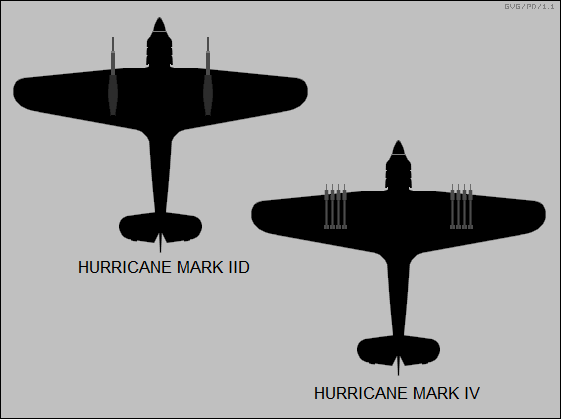
Mark IVs were fitted with a Merlin 24 or 27 engine, optimized for hot-climate operation and with 1,208 kW (1,620 HP), driving a three-blade propeller. They were all fitted with a new wing that could carry two bombs; eight "60-pounder" rockets; or twin 40-millimeter cannon as needed, rationalizing production. The stores could be "mixed and matched" to a large degree, for example with a cannon under one wing; a bomb under the other; and four RPs, two under each wing. About 794 Mark IVs were built, not counting conversions from other marks.
Rocket armament had been evaluated on Hurricanes beginning in early 1942. The Hurricane Mark IV was the first rocket-armed aircraft to be used in action by the Western Allies, and the rocket armament gave it a tremendous punch, being generally more effective than the light bombs carried by earlier Hurribombers. The Hurricane paved the way for the tactical use of rocket-firing Hawker Typhoons, which would largely take over the "trade" from the Hurricanes in Europe, the displaced Hurricanes moving on to the Far East.
* The "Mark III" was intended to be a British-built Hurricane fitted with a US / Packard-built Merlin engine, but since Rolls-Royce proved able to keep up with Hurricane production, the Mark III never even flew as a prototype. Two Hurricane "Mark Vs" were built as conversions of Mark IVs, and featured a Merlin 32 engine driving a four-bladed propeller. Since stocks of Mark IVs were adequate, there proved to be no need for the Mark V.
The last Hurricane to be built was rolled out in July 1944. The Hurricane had been reassigned to second-line roles in the European theater by the middle of the war, though it continued in combat in Burma to the end of conflict. The Hurricane was finally phased out of RAF service in December 1946, when Number 6 Squadron on Cyprus traded their Hurricanes in for de Havilland Vampires.
BACK_TO_TOP* The Hurricane was regarded as such an important weapon that the Canadian Car & Foundry (CCF) company was contracted in 1938 to build the Hurricane I at the CCF factory in Fort William, Ontario. A batch of 20 Hurricane Is, plus a manufacturing pattern aircraft, was shipped to Canada in October 1938. The first Canuck Hurricane performed its initial flight on 9 January 1940.
Initial Canadian Hurricanes used Rolls-Royce Merlin engines and were simply referred to as "Canadian Mark Is", with about 40 built, but later Canadian Hurricanes had their own variant designations:
CCF built Hurricanes both at Fort William and at a second plant in Montreal. The Canuck Hurricanes saw service all over the world, though many were retained by the Royal Canadian Air Force (RCAF) in North America for training. For some reason, many Canadian Hurricanes were flown without prop spinners.
* The Soviet Union was the biggest export user of the Hurricane. Two RAF squadrons, Numbers 81 and 134, were built up in the summer of 1941 and sent to Murmansk on the HMS Argus, along with 200 Hurricanes in crates. The main objective of the RAF squadrons was to get the Soviets up to speed on the aircraft, but while they did so the Britons also flew plenty of combat missions, racking up scores against the Luftwaffe.
The Soviets formed their own Hurricane squadrons in the fall of 1941, and the Britons went back home. The Hurricane did well under rough Eastern front conditions, with most fitted with Vokes filters to allow operation from dusty forward airstrips, and though there are records of Stalin complaining about the type, it seems that Soviet fliers generally liked it a great deal. In fact, the Hurricane in some ways resembled Russian aircraft, in that it was built simple and rugged.
About 2,952 Hurricane Mark IIs and IVs and Canadian-built equivalents were supplied to the USSR during the war. Many were refitted with Soviet-built armament, for example two ShVAK 20-millimeter cannon and two UBT 12.7-millimeter (0.50-caliber) machine guns. It seems plausible that the rearming of Soviet Hurricanes was partly driven by difficulty of supply of Western ammunition, suggesting that most Hurricanes were modified in this way. The relatively high rate of fire of Soviet automatic weapons, about half again as great as their Western equivalents, also gave their re-armed Hurricanes a nastier bite.
* Other export users included:
* The Hurricane also saw service with the British Royal Navy's Fleet Air Arm (FAA). Early in the Battle of the Atlantic, Focke-Wulf Fw 200 Kondor ocean-patrol aircraft and other Nazi aircraft were taking a terrible toll in Allied shipping, and the Royal Navy didn't have enough carriers to provide air cover for the convoys. As a stopgap measure, in early 1941 a plan was devised in which a Hurricane would be shot off a rocket-driven catapult mounted on a merchant vessel to take on the Kondor. The pilot would make his way to a land base if possible, or otherwise try to ditch near a vessel so he could be fished out of the sea. A rocket-boosted catapult was very unusual, the more common scheme being to use compressed air, but it was a perfectly workable approach, and allowed a catapult to be fitted to any vessel that had space for it.
The whole "Catapult Armed Merchantman (CAM)" ship scheme was regarded as recklessly dangerous, but there was no other option available at the time, and it was adopted. The slogan at the time was: "Desperate times give rise to desperate measures." Some sources claim that Winston Churchill himself came up with the idea, which is plausible since it fit his flair for the outrageous, but it appears it was thought up by a Captain M.S. Slattery of the Royal Navy.
Small numbers of Fairey Fulmars were originally pressed into service as CAM fighters, and then about 50 Hurricane Is were modified by General Aircraft for catapult launch from a CAM ship -- changes including airframe reinforcement and fit with catapult spools. These aircraft were given the designation "Sea Hurricane IA", though they were more informally referred to as "Hurricats". A total of 35 merchantmen was configured as CAM ships, with the first Atlantic crossings of such vessels in the spring of 1941. The Royal Navy also operated five "Fighter Catapult Ships (FCS)", based on miscellaneous vessels including seaplane tenders and anti-aircraft ships, but they carried the Fulmar.
CAM ships carried two Hurricats, with two pilots for each Hurricat, the pilots alternating on standby at times of risk to make sure a fighter could be launched immediately. The pilots were trained on a ground-based catapult system, with three launches during a two-week cram course.
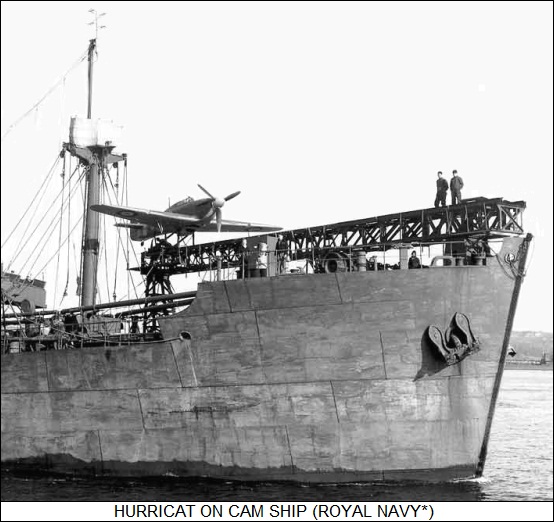
Statistics for CAM-ship operations are entirely obscure, with only seven confirmed kills, in 1942 and 1943. Some sources indicate there were other kills in 1941. Numbers of launches, numbers of pilots lost, and other details remain unclear. It appears that CAM ship Hurricat launches were generally done only as a last resort -- not only because of the risk to the pilot, but because the bright flare of the rocket catapult attracted unwanted attention. CAM ships themselves lived hazardous lives, with some sources claiming that a third of them were torpedoed and sent to the bottom.
Eventually, the availability of small escort or "jeep" carriers eliminated the need for the CAM ships, and the CAM ships were out of business by the summer of 1943. The Hurricane was operating off the jeep carriers by this time. Following the 50 Sea Hurricane IAs for the CAM ships, 250 Hurricane Is were refitted with both catapult spools and yoke-style frame arresting hooks for carrier operation, to be designated "Sea Hurricane IB". They went into FAA service beginning in mid-1941.
The Sea Hurricane IB was followed by the "Sea Hurricane IC" in early 1942, which was essentially a converted Mark I with Sea Hurricane IB kit and the four-cannon wing. It was the only Mark I that went into service to carry such heavy armament. It lacked adequate power for such a load, but the speed penalty was felt acceptable, since the primary adversary was expected to be Luftwaffe patrol bombers.
The "Sea Hurricane IIC" was a Hurricane Mark IIC with a Merlin XX engine and the carrier kit of a Sea Hurricane IC. A number of Canadian-built Mark XIIs were also converted to Sea Hurricane standard, and designated "Sea Hurricane XIIA", or sometimes "Sea Hurricane XIIB" or "XIIC" as per armament fit.
The Sea Hurricane force was gradually drawn down through 1943, with the last FAA squadron flying it disbanded in April 1944. The Sea Hurricane had proven a very useful weapon in its time, though it tended to be a bit of a handful to land on a carrier, due to its long nose and tendency to bounce. Pilots also didn't like to ditch the machine, preferring to bail out if possible, since water flooded through the radiator scoop on the bottom, and the aircraft sank like a brick.
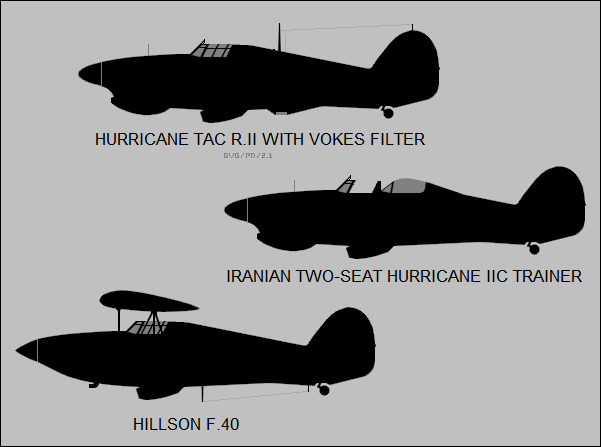
* Given the large number of Hurricanes built, there were of course many unusual modifications and special variants:
Total Hurricane production tallies to 12,302 aircraft, though there is substantial disagreement between sources. Variants included:
The Hurricane is now fairly common as a museum display, and a number remain flying as airshow warbirds.
BACK_TO_TOP* While the Hurricane was a great success story, there was a footnote to that story that was far less impressive, in the form of the Hawker "Henley" and "Hotspur".
In February 1934, the British Air Ministry issued specification "P.4/34", requesting designs for a light bomber that could be used in the close-support role, with a top speed of over 480 KPH (300 MPH) and a 450-kilogram (1,000-pound) bomb load. Hawker proposed a derivative of what would become in the Hurricane, which hadn't even flown at that time, with Hurricane outer wing panels, tail, and Merlin engine. Hawker got the go-ahead to build a prototype and began work on it in mid-1935, but the company's preoccupation with the Hurricane meant that the prototype of the "Henley", as it was called, didn't perform its first flight until 10 March 1937.
The Henley was broadly similar in overall configuration to the Hurricane, but had a stockier fuselage, and a tandem cockpit with a rear-facing gunner / observer. Defensive armament was apparently to be a single flexible machine gun mounted at the rear of the cockpit, with no guns in the wings. The bombload was carried in a small bomb bay.
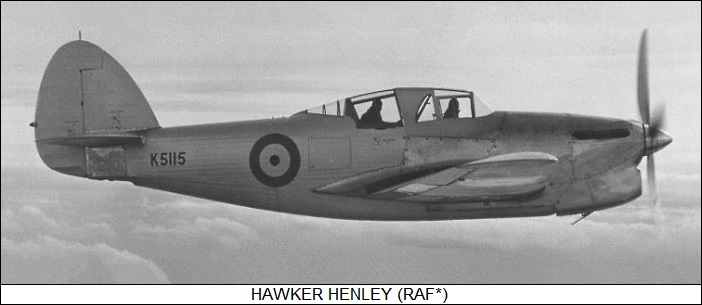
Performance was over specification, but by this time the Air Ministry had decided they didn't want a light bomber after all. There was, however, a need for a target tug, and so an arrangement was set up where Gloster was to build 200 Henleys for that role under subcontract. A second prototype of the Henley, configured for the target tug role with a windmill-driven target tow winch, performed its initial flight on 26 May 1938. Production aircraft followed, designated "Henley TT Mark III", fitted with Merlin II or III engines, and went into service with RAF air gunnery schools.
___________________________________________________________________
HAWKER HENLEY TT.III:
___________________________________________________________________
wingspan:
14.59 meters (47 feet 10 inches)
wing area:
31.77 sq_meters (342 sq_feet)
length:
11.1 meters (36 feet 5 inches)
height:
4.46 meters (14 feet 8 inches)
empty weight:
2,726 kilograms (6,010 pounds)
MTO weight:
3,846 kilograms (8,480 pounds)
max speed with target:
438 KPH (272 MPH / 236 KT)
service ceiling:
8,230 meters (27,000 feet)
range:
1,530 kilometers (950 MI / 825 NMI)
___________________________________________________________________
In practice, the Henley was not powerful enough to tow a big and draggy target at a useful speed, and attempts to prove otherwise led to persistent engine failures plus losses in accidents. The Henleys were finally withdrawn from service in mid-1942, probably to the relief of all concerned, and replaced by Boulton-Paul Defiants modified to the task, and by the purpose-designed Miles Martinet target tug.
* The branch of the Hurricane story that led to the Henley led in turn to another branch, the "Hotspur". In 1935, the Air Ministry issued a request under specification "F.9/35" for a two-seat interceptor fighter. Both Hawker and Boulton Paul responded with proposals, with both designs featuring a Boulton Paul turret with four 7.7-millimeter Browning machine guns. Turret fighters were something of a fad at the time, the idea being that it gave the fighter the flexibility to shoot at a target from any angle of attack -- though in practice the concept would prove clumsy and unworkable.
The Boulton Paul offering would go into production as the "Defiant", which had a less than glorious service history. The Hawker offering, based on the Henley, did materialize as a single Hotspur prototype. Due to Hawker's preoccupation with Hurricane production, the Hotspur prototype didn't fly until 14 June 1938. It looked much like the Henley, except for a modified cockpit with a dummy turret in the back. The turret was ballasted to the projected weight of the real thing.
Although the Hotspur's performance was better than that of the Defiant, and in fact was not that much inferior to that of the Hurricane, with a top speed of well over 480 KPH (300 MPH), by this time Hurricane production was an absolute priority. Work on the Hotspur was abandoned, which was just as well. The prototype was used for trials for a few years.
* As far as the Henley went, there are those who maintain that it might have done very well in its originally intended role of light bomber. That might or might not be the case, but what is certainly true that the Henley, and its offspring the Hotspur, were among the more forgettable combat aircraft ever built.
BACK_TO_TOP* I never quite grasped the historical dominance of the Spitfire over the Hurricane until I went to my diecast aircraft source to get a model of a Hurricane. After considerable poking around and finding Spitfires in a range of scales, I was able to find a 100th-scale Hurricane IID, and not a very impressive one at that. I suppose diecast manufacturers have to sell where the money is, but it still seems somewhat regrettable.
Modelers have, however, been interested enough in the Hurricane to come up with some "what-if" variants of the type, such as a bubble canopy or Bristol Hercules radial engine. The bubble canopy might have required too many structural changes to be practical, but the radial engine seems like it would have been plausible.
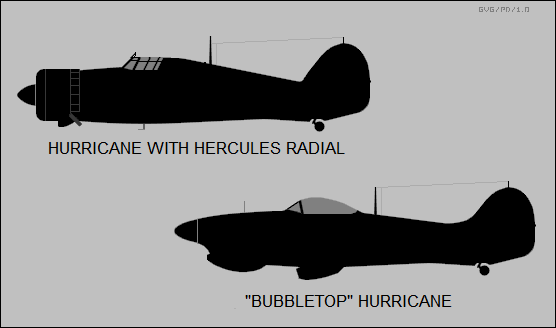
* Sources include:
* Revision history:
v1.0.0 / 01 nov 02 v1.0.1 / 01 jun 03 / Minor corrections. v1.0.2 / 01 jun 05 / Review & polish. v1.0.3 / 01 may 07 / Review & polish. v1.0.4 / 01 apr 09 / Review & polish. v1.0.5 / 01 oct 10 / Review & polish. v1.0.6 / 01 sep 12 / Review & polish. v1.0.7 / 01 aug 14 / Review & polish. v1.0.8 / 01 jul 16 / Review & polish. v1.0.9 / 01 jun 18 / Review & polish. v1.1.0 / 01 apr 20 / Review & polish. v1.1.1 / 01 feb 22 / Review & polish. v1.2.0 / 01 jan 24 / Updated variant summary. (+)BACK_TO_TOP
